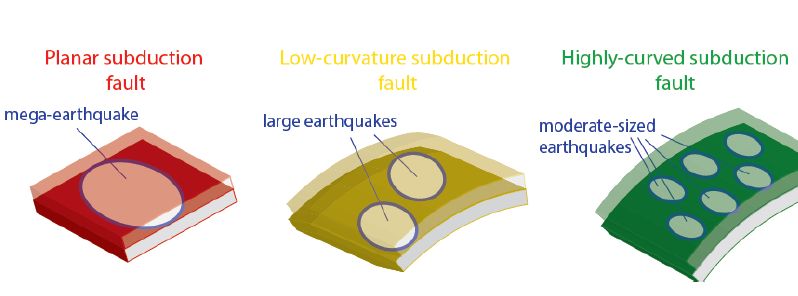Mega-earthquakes more frequent in flat subduction zones

A new study, conducted by the scientists from the University of Oregon and Géoazur laboratory, suggest the mega-earthquakes are the most frequent on the flattest regions of subduction zones, instead of evenly distributed. The research aims at contributing to earthquake monitoring and seismic and tsunami risk prevention.
Mega earthquakes, the quakes of magnitude greater than 8.5, are known to occur on subduction faults, in regions where one tectonic plate pushes under the other. The movement of tectonic plates is not always easy, as it can be blocked throughout the entire length for more than thousands of years. Such an occurrence, namely the 'slip deficit' results in accumulating large amounts of energy, which gets released when the earthquakes happen.
So far, a widely accepted theory was that such powerful quakes mainly take place in regions where the tectonic plates rapidly converged or where they were of relatively young age.
The mega earthquakes, which produced dangerous tsunamis, reported in Sumatra-Andaman in 2004 and Tohoku-Oki in 2011, have proven the long upheld theory may be prone to faults. In the Sumatra-Andaman, the plates were moving at a relatively slow pace of about 3 to 4 cm (1.2 to 1.6 inches) in a year. In the second case, the Pacific plate is more than 120 million years old.

When a subduction plate is flat (left), the rupture threshold can cause mega-earthquakes. However, when highly curved, the threshold is more heterogeneous, causing more frequent, but moderate, earthquakes. Image credit: Quentin Bletery
To investigate such events, the scientists have studied the subduction zone geometry. They compared the curvature degree of the subducting plates in large historical earthquakes events and found out that the maximum magnitude of the quakes was inversely proportional to the degree of the curvature of the fault. This means the flatter the contact between the two tectonic plate is, the greater the probability of a mega-earthquake.
In general, the quakes happen when the accumulated energy exceeds a threshold. The larger is the curvature of the subduction fault, the more will the threshold vary along the subduction zone. Earthquakes are more frequent in the regions of a heterogeneous threshold. However, they affect a much smaller area, and are, consequently of lower magnitude. The homogenous threshold over a large fault area will more likely result in a simultaneous rupture of the entire blocked zone, in turn producing a mega earthquake.
The research explains why some subduction zones, like the Philippines, Salomon Islands or Vanuatu don't produce mega-earthquakes while Peru, Java, and Mexico, are capable of producing them, although a large earthquake hasn't occurred there over the last 200 to 300 years.
Reference:
- "Mega-earthquakes rupture flat megathrusts" – Quentin Bletery, Amanda M. Thomas, Alan W. Rempel, Leif Karlstrom, Anthony Sladen, Louis De Barros – Science (2016) – DOI: 10.1126/science.aag0482
Featured image: Featured image: When a subduction plate is flat (left), the rupture threshold can cause mega-earthquakes. However, when highly curved, the threshold is more heterogeneous, causing more frequent, but moderate, earthquakes. Image credit: Quentin Bletery

Commenting rules and guidelines
We value the thoughts and opinions of our readers and welcome healthy discussions on our website. In order to maintain a respectful and positive community, we ask that all commenters follow these rules.